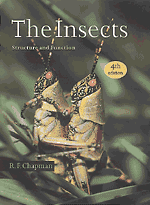Book contents
- Frontmatter
- Contents
- Preface
- Acknowledgments
- PART I The Head, Ingestion, Utilization and Distribution of Food
- 1 Head
- 2 Mouthparts and feeding
- 3 Alimentary canal, digestion and absorption
- 4 Nutrition
- 5 Circulatory system, blood and immune systems
- 6 Fat body
- PART II The Thorax and Locomotion
- PART III The Abdomen, Reproduction and Development
- PART IV The Integument, Gas Exchange and Homeostasis
- PART V Communication
- Taxonomic index
- Subject index
3 - Alimentary canal, digestion and absorption
Published online by Cambridge University Press: 05 June 2012
- Frontmatter
- Contents
- Preface
- Acknowledgments
- PART I The Head, Ingestion, Utilization and Distribution of Food
- 1 Head
- 2 Mouthparts and feeding
- 3 Alimentary canal, digestion and absorption
- 4 Nutrition
- 5 Circulatory system, blood and immune systems
- 6 Fat body
- PART II The Thorax and Locomotion
- PART III The Abdomen, Reproduction and Development
- PART IV The Integument, Gas Exchange and Homeostasis
- PART V Communication
- Taxonomic index
- Subject index
Summary
ALIMENTARY CANAL
The alimentary canal of insects is divided into three main regions: the foregut, or stomodeum, which is ectodermal in origin; the midgut, or mesenteron, which is endodermal; and the hindgut, or proctodeum, which again is ectodermal (Fig. 3.1). The epithelium of all parts of the gut consists of a single layer of cells.
Since the foregut and hindgut are ectodermal in origin, the cells secrete cuticle which is continuous with that covering the outside of the body. The lining cuticle is known as the intima. It is shed and renewed at each molt. Although the midgut does not secrete cuticle, in most insects it does secrete a delicate peritrophic envelope around the food.
Usually the gut is a continuous tube running from the mouth to the anus, but in some insects that feed on a fluid diet containing little or no solid waste material the connection between the midgut and the hindgut is occluded. This is the case in some plant-sucking Heteroptera, where the occlusion is between different parts of the midgut (see Fig. 3.9), and in larval Neuroptera which digest their prey extra-orally. A similar modification occurs in the larvae of social Hymenoptera with the result that the larvae never foul the nest. In these insects a pellet of fecal matter is deposited at the larva–pupa molt.
- Type
- Chapter
- Information
- The InsectsStructure and Function, pp. 38 - 68Publisher: Cambridge University PressPrint publication year: 1998
- 11
- Cited by



